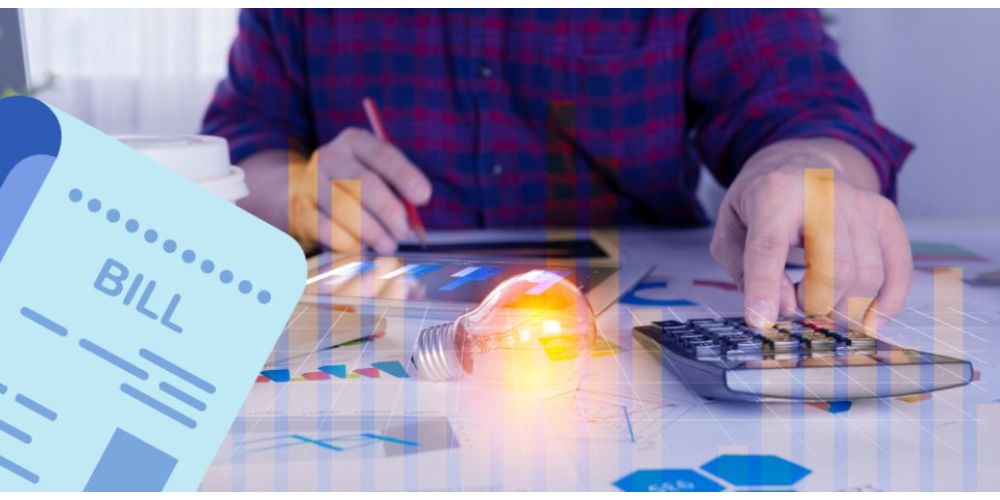One of the most terrifying yet common challenges in adult life is paying utility bills month after month and year after year. Electricity bills constitute a significant portion of household and business utility expenses. Whether you are a young adult moving out of your home for the first time or a family man/woman taking care of your household, paying your energy bills is a normal part of life.
Furthermore, electricity bills can often vary significantly, presenting a challenge for many homeowners and businesses. Understanding your electricity bill and the reasons behind fluctuating energy bills is crucial for your household or business budgeting. But that's not all. It is also essential to gain insight into these charges, how they are determined, and what factors contribute to their fluctuation.
An in-depth understanding of your monthly electricity bill can help you manage costs and make informed decisions. Doing so ultimately leads to more efficient energy use and potential savings. At first glance, your energy payments may seem straightforward—you pay for the electricity you use. However, the system behind electricity billing is much more intricate and shaped by various factors.


You could understand this by looking closer at your electricity bill because you will likely not understand the bill's breakdown. Most of us look at the amount mentioned in the bill, pay it, and get on with our lives. According to Bankrate, U.S. households' average monthly electricity bill is around $115 monthly and $1644 yearly. This figure underscores the importance of understanding the charges on your electricity bill and taking proactive steps to manage and reduce those costs.
This blog post offers a comprehensive guide to optimizing energy usage and expenses. We will discuss everything from the basics of billing cycles and the components of your bill to the external factors that influence your monthly charges. Whether you want to understand your monthly electricity bill or reduce energy costs, this post will provide valuable insights and practical tips to achieve your goals.
Understanding Your Electricity Bills and the Basics of Energy Billing
The first step to understanding your electricity bills is to define them. An electricity bill is a periodic statement reflecting the cost of the electricity consumed within a specific timeframe. Usually, this timeframe is a month or even two, but it can vary based on the plan and provider you choose. You will encounter specific industry terms or jargon when examining your electricity bills.
Unfortunately, understanding the electricity bill is only possible if you know these terms or jargon. For instance, the billing cycle is one of the terms you are likely to encounter if you are trying to optimize your energy consumption habits. So, before we discuss the various components of your electricity bill, let's first discuss the essential electric company jargon.
Common Terms and Jargon Used by Electric Companies
Below are some standard terms and jargon you must familiarize yourself with to understand your electricity bills and expenses fully.
Billing Cycle
The billing cycle is the period for which your energy usage is measured. Although the most common billing cycle is one month, it is only sometimes the case.
Meter Multiplier
When the usage is too large to display on the meter, a "meter multiplier" is applied to recalculate the actual energy consumption. In such cases, the meter shows a fraction of the actual use, and the electric company uses the meter multiplier to arrive at the correct reading.
Meter Reading Type
It indicates how the reading of your electric meter is obtained. There are three ways to acquire this reading, which are listed below.
- Directly by a utility representative (Actual)
- Self-reported by the customer (Customer)
- Based on past data (Estimated)
Metering Charge
It is the fee associated with maintaining and monitoring your electricity meter to ensure accurate energy usage tracking.
Purchased Electricity Adjustment
It is an adjustment that corrects discrepancies between the rate charged for you and the actual cost to the supplier used by some electric companies.
Customer Charge
A fixed administrative fee is designed to cover the cost of customer service, independent of your energy usage.
Consumer Education Charge
It is a monthly fee charged by some companies for providing consumers with ongoing education about their bills, selecting electricity providers, and learning energy-efficient practices.
Distribution Charge
Distribution charges are often fees related to the infrastructure that delivers electricity to your home, including local wiring and transformers.
Environmental Cost Recovery Adjustment
Electric companies may charge you compensation for the utility's environmental initiatives or activities aimed at environmental improvement.
Franchise Cost
It is the charge electric companies use to offset the utility fees paid to the municipality for the privilege of operating within its jurisdiction.
Energy Efficiency Programs
Electric companies recover the costs associated with mandated green initiatives to promote energy conservation and efficiency via this fee.
Breaking Down Your Electric Bill
The simple way to break down your electric bill is to split it into two—supply charges and delivery charges. The logic behind these charges is the same as when you place an Uber Eats order, where you pay for the food and the delivery. Similarly, your electric bill consists of payment for the energy producer and the company that delivers the energy from the provider to your home.
Supply Charges
The supply charge is the cost of generating electricity. Two types of entities can supply electricity to your household or business.
- Your local electricity utility company that is responsible for delivery electricity in your area. They typically offer a default supply rate that adjusts periodically with the market for those customers who do not switch to a competitive energy supplier. (Eg: Eversource in Massachusetts)
- Or a competitive supplier. (Eg: Clearview in Massachusetts)
Fun Fact: In the deregulated areas of Texas, customers are actually mandated to switch to a competitive supplier. Their local electricity utility companies do not offer a default supply rate.
Delivery Charges
The second key element of your bill is the delivery charge. It encompasses the following charges.
- Transmission Charges: This fee supports the transmission system's construction, maintenance, and operation, transporting electricity from power generators to local distributors.
- Distribution, Operations, and Service Charges: These include the costs of delivering power to homes, maintaining infrastructure, customer service, and enhancing grid reliability.
- Public Policy Charges: These charges fund initiatives such as energy efficiency, renewable energy, electric vehicle programs, and distributed solar projects.
It is critical to note that delivery service rates can vary depending on the location. For instance, electricity rates in Texas differ from those in other parts of the U.S. due to its deregulated energy market. In a deregulated market, electricity rates in cities such as Houston and Dallas are likely to be lower and highly competitive compared to other regions.
Understanding the Unit of Measurement Used for Measuring Your Electricity Usage
Electric companies and providers measure electricity usage in kilowatt-hours (kWh). It is the amount of energy you consume over a specified time. One kWh reading means your household or commercial electricity usage amounts to 1,000 watts for one hour. One can find the total cost of electricity by multiplying the kWh from the meter reading with the rate you agreed to pay per kWh during the specific time, usually a month.
Get expert advice to minimize the kWh consumption for residential and commercial buildings
What are the Factors Affecting Your Electric Bills?
Several factors can significantly influence the total amount on your electricity bill. These factors can broadly fall into three categories as listed below.
- Energy consumption habits or patterns.
- Utility provider's pricing structure.
- Energy efficiency measures.


Energy Consumption Habits
Your energy consumption habits or patterns can change over the year, which can significantly impact your utility expenses. Below, we discuss how your energy consumption habits can impact your periodic electric bills.
Seasonal Variations
Energy use typically increases during extreme weather conditions, like peak summer and winter. It often leads to higher heating or cooling requirements at home, resulting in expensive electric bills.
Time-of-use Pricing
Some utilities adjust their rates based on demand, charging more during peak hours. Hence, you must ensure that your utility company has a time-of-use charge so you can minimize power usage during peak hours.
Lifestyle Changes
Adding new home electronic appliances or changes in household occupancy can significantly affect your energy usage, reflecting on your electricity bills.
Pricing Structures
The utility company's rate structure is another critical factor in determining your average electricity expenses. Here is how the rate structure of the utility company can impact your periodic electric bills.
Fixed Vs. Variable Rates
Electric companies use two major pricing structures: fixed and variable rates. Fixed rates remain the same throughout your contract period, while variable rates can fluctuate with the market. Both structures offer unique advantages and challenges to the energy consumer.
Tiered Pricing
Another pricing structure adopted by utilities is tiered pricing. These charges increase as you consume more electricity. In other words, the energy costs go up significantly if you leave it unsupervised, encouraging energy conservation practices by individuals and businesses.
Demand Charges
The demand charge applies only to commercial energy customers. It is determined based on the energy consumed within a specified interval of time, which is more popularly called the demand interval.
Energy Efficiency Measures
Your energy efficiency measures also contribute to your final electricity bill. Several energy efficiency measures can help you reign in your energy usage to the desired limits.
Energy-efficient Appliances
With the ENERGY STAR label, modern electric appliances can help you minimize your energy consumption without sacrificing performance. Whether refrigerators, dishwashers, or HVAC systems, these upgrades can significantly save your electricity bills over time.
Home Insulation and Weatherization
Effective insulation and Weatherization are vital to maintaining your home's temperature. Insulation is a barrier to heat loss and gain, while Weatherization measures sealing leaks around your doors and windows. As a result, you can significantly reduce the load on your HVAC system and effectively minimize your electric bills.
Smart Thermostats and Energy Monitoring Devices
Smart thermostats offer an advanced way to control your home's heating and cooling systems. On the other hand, energy monitoring devices provide real-time insights into your electricity consumption habits. That's not all. They can adapt to your schedule and preferences to control your home temperature automatically and let you identify high-energy-consuming devices.
Interested to learn how you can lower the household electricity bills with advanced energy efficient measures?
Understanding Peak Demand
Peak demand is yet another term you are likely to encounter when researching various sources for minimizing your household or business electricity consumption. It refers to when electricity usage spikes, typically during specific hours of the day or particular seasons.
Peak demand for electricity is often a direct result of collective consumer behavior. Furthermore, this concept is crucial for both residential and commercial users, as it directly influences electricity grid operations and, consequently, the cost of electricity.


Peak Demand Charges for Commercial and Industrial Customers
Managing peak demand is especially important for commercial and industrial users. The challenge with peak demand charges is that they depend on the highest electricity level used during peak periods. This means peak demand charges reflect the additional costs utilities incur to meet your increased energy demand. As you can imagine, peak demand charges can significantly sway your electricity bills, whether yours is a residential or commercial building.
A commercial or industrial electricity consumer typically gets peak demand charges based on their energy usage during each billing cycle. For a commercial customer, peak demand is the highest average electricity usage during a specific interval of the billing period. Businesses strive to reduce peak consumption through various strategies, including shifting high-power activities to off-peak hours or investing in energy storage solutions.
As of November 2023, the industrial electricity rate in the U.S. is 7.9 U.S. cents per kilowatt-hour. Considering the large amount of electricity consumed by commercial and industrial establishments, peak demand can significantly impact their overall revenue. Hence, it is essential to prepare and plan for peak demand charges.
Peak Demand Charges for Residential Customers
Residential electricity consumers are typically not subject to direct peak demand charges. However, households can also benefit from being mindful of peak demand periods. Some utilities offer time-of-use (TOU) pricing plans that charge lower rates during off-peak hours, encouraging consumers to adjust their usage accordingly.
By doing so, households can contribute to sustainable energy usage while preventing grid overloads and enjoying lower electricity costs. By aligning energy usage with times when demand is lower, residential consumers can help ensure a reliable and environmentally friendly electricity supply.
Impact of Renewable Energy Sources on Your Electric Bills
The integration of renewable energy sources into the electricity grid is perhaps the most effective way to minimize electricity expenses. It makes a significant shift in energy dynamics and opens up endless opportunities. However, it also comes with challenges for grid management and consumer costs.
Not to mention, the initial investment for most renewable energy is significantly high. The shift towards renewable energy sources, such as solar, wind, and hydroelectric power, transforms the electricity grid. More importantly, it is changing how we think about energy consumption and billing.
Integration of Renewable Energy Into the Grid
Integrating renewable energy into the electricity grid is the most significant shift you can make towards sustainable energy practices. It involves adapting the grid to accommodate variable energy sources that depend on the natural conditions you live in, such as the availability of sunlight or strong wind.
You can integrate renewable energy into the grid yourself (e.g., by installing solar panels) or with the help of utilities and grid operators. Utilities and grid operators are developing smarter, more flexible grid systems that can manage fluctuations in renewable energy availability, ensuring a reliable supply of electricity.
The most convenient way to integrate renewable energy into the grid is to use one of the following approaches.
- Green energy programs from utilities
- Community solar projects
- Energy supplier options (in deregulated energy markets)
Expert Advice: Consider purchasing Renewable Energy Certificates (RECs) to support renewable energy and claim/offset energy produced from renewable sources.
Effects of Integrating Renewable Energy on Electricity Pricing and Billing
The increasing presence of renewable energy sources notably impacts electricity pricing and billing. As the cost of renewable technology continues to decrease, the price of generating electricity from these sources becomes significantly less in the long run. The core features of renewable energy that let you access lower electricity prices are as follows.
- Lower energy generation costs
- Self-generation of energy and net metering
- Government Incentives for Renewable Energy Adoption
Make your switch to sustainable energy today
Regulatory Factors Impacting Your Electricity Bills
Regulatory bodies and government policies play a critical role in determining electricity charges. Hence, it is essential to understand these regulatory factors to gain a more comprehensive insight into why electricity bills fluctuate.


What is the Role of Regulatory Bodies in Setting Electricity Rates?
Regulatory bodies, including the Federal Energy Regulatory Commission (FERC) and state public utility commissions, are critical in determining electricity rates. They oversee the electricity market, ensuring that rates are fair and transparent. These organizations also ensure that electric companies specify the cost of generating, transmitting, and distributing electricity in their bills.
Impact of Government Policies and Regulations on Electricity Bills
Government policies and regulations can also significantly impact your electricity bills. Initiatives like renewable energy promotions and solar and wind power subsidies are excellent examples. The government also releases policies regarding energy efficiency, emissions reductions, and grid modernization that can impact your electricity rates.
Consumer Rights and Protections
Regulatory bodies, such as the ones discussed above, help enforce consumer rights and protections. As an energy consumer, you have the right to fair billing practices and access to clear and understandable bill explanations. Furthermore, you can dispute charges or report service problems, which we discuss in detail in the following sections.
What are Utility Fees and Surcharges on Electricity Bills?
Understanding the fees and surcharges on your electricity bill can be challenging. These additional charges significantly affect the amount due each month, even though they are not part of your primary electricity usage.
Utility fees and surcharges are added to bills for various reasons. However, the primary objectives include maintaining the electrical grid, funding renewable energy projects, and complying with state and federal regulations.
Common Surcharges and Their Purposes
| Surcharge | Purpose |
|---|---|
| Grid Maintenance Fees | Upkeep and improvement of the electrical infrastructure. |
| Renewable Energy Surcharges | Support the integration and development of green energy sources. |
| Regulatory Compliance Fees | Cover the costs related to legal and regulatory requirements. |
Strategies to Minimize Surcharge Costs
It is almost impossible to avoid utility fees and surcharges entirely. However, if you are conscious enough about your energy consumption habits, you can help minimize these surcharges. Some effective strategies to reduce the surcharges on your electic bills are as follows.
- Opting for energy-efficient appliances
- Participating in energy savings programs
- Staying informed about your utility's billing practices
How to Handle Electricity Billing Errors and Disputes
One of the most common questions people have about their electricity billing is how they can handle errors and disputes on their electricity bills. Here, we explain the common billing errors in electricity bills and how you can handle disputes on your bills.
Common Types of Billing Errors in Electricity Bills
- Data entry mistakes
- Incorrect meter readings
- Incorrect rate application
- Charges for services not received
Steps to Take When Disputing Your Electric Bill
With several regulatory bodies protecting the interests of the electricity consumer, it is relatively easy to raise disputes and arrive at resolutions quickly. Here are a few steps you can take in the case of a dispute regarding your household or business electricity bills.


Step 1: Review your bill, compare current charges with previous months, and check for unusual spikes.
Step 2: Gather evidence, such as meter readings or account history.
Step 3: Contact Your Utility Provider to discuss the bill and present your findings.
(Most companies are willing to rectify billing errors once identified)
Step 4: Document everything from communications to agreements.
If you are unsatisfied with the utility company's response, you can also consider legal action, including launching an investigation and suing in Small Claims Court.
Consumer Rights and Protections Against Billing Inaccuracies
Consumers are protected against unfair billing practices. Regulatory bodies require utility companies to investigate disputes and correct any errors. If the consumer does not get a satisfactory resolution, they can escalate their complaint to a higher authority, such as a state regulatory commission or consumer protection agency.
Having issues with your current electricity provider?
Conclusion
Understanding the nuances of your electricity bill is more than a financial necessity; it's a step toward energy independence and environmental sustainability. This article, including standard terms and jargon used by electric companies, can help you better understand fluctuations in your electric bills.
Understanding how supply and delivery charges are determined and recognizing the impact of regulatory fees and adjustments allows you to minimize your monthly utility expenses. Even though you can take several measures to stabilize your monthly electricity expenses, this is only sustainable when you adopt the best energy consumption habits.
Understanding the Fluctuations in Your Monthly Electricity Bills: FAQs
Why do energy rates fluctuate throughout the year?
Energy rates fluctuate for several reasons. Changes in demand, fuel costs, and various market conditions are common causes. A higher load on HVAC systems during peak summers and winters also leads to increased rates. Fluctuations in the cost of generating electricity and regulatory changes can also influence energy rates.
How do time-of-use rates affect my electricity bill?
Time-of-use rates vary electricity prices based on when the consumer uses the energy. During peak hours, energy demand and electricity rates are highest. The rates are lower during off-peak hours (typically at night or on weekends). This model encourages you to shift their electricity use to off-peak times.
Can external factors like weather impact my electricity rates?
Weather can significantly impact energy rates for your residential or commercial property. Extreme temperatures increase the demand for heating or cooling, leading to higher operational costs. Furthermore, additional power generation resources are sometimes needed, which are often more expensive. Weather calamities can also disrupt supply chains or damage infrastructure.
Why do energy rates differ from place to place in the U.S.?
Energy rates vary from one region to another due to several reasons. The primary reasons for the varying electricity rates include differences in fuel availability, energy generation sources, and state regulations. Furthermore, the efficiency of the local transmission and distribution system also contributes to this.
What impact do renewable energy sources have on electricity rates?
The integration of renewable energy sources into the power grid can stabilize electricity rates over time. Although the initial investment in renewable energy is high, the operational costs are generally low, and the investment pays for itself in the long run. Furthermore, the share of renewables in the energy mix is growing steadily.
What does a meter multiplier on my electric bill indicate?
A meter multiplier is applied when the electric meter can't indicate energy usage because it exceeds the meter's display limit. Hence, the actual meter reading shows only a fraction of your use. The meter multiplier ensures accurate billing by multiplying the displayed usage back to your actual consumption, especially for commercial buildings.
What are metering charges on electricity bills?
The metering charges on your electricity bills are fees related to maintaining and reading your electricity meter. The utility company uses the metering services to accurately track and bill your energy usage. Furthermore, the metering charges cover costs related to the technical upkeep and operational logistics of metering equipment.
What is a purchased electricity adjustment?
A purchased electricity adjustment is applied when there's a discrepancy between the electricity rate charged to you and the actual cost incurred by the supplier. Electricity suppliers like ComEd balance their financial books this way. While the process may seem a little complex, it ensures actual energy market costs.
What's a customer charge on my electricity bill?
The customer charge on your electricity bill is a fixed monthly fee covering the utility's administrative and service costs, including customer support. Unlike variable charges based on usage, this fee remains the same, allowing the utility to maintain service quality regardless of individual energy consumption levels.
What is there a consumer education charge on my electric bill?
Electric companies charge a consumer education fee for ongoing education programs about electricity billing. The program could be about choosing suppliers, energy conservation strategies, etc. It is also worth noting that the fee supports initiatives that promote sustainable energy usage and efficiency improvements.

